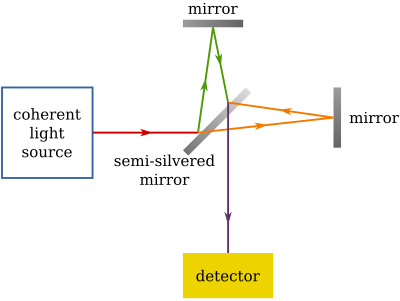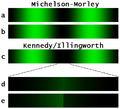Michelson–Morley experiment facts for kids
The Michelson–Morley experiment was a scientific experiment to find the presence and properties of a substance called aether. Aether was believed to fill empty space. The experiment was done by Albert Michelson and Edward Morley in 1887.
Since waves in water need something to move in (water) and sound waves do as well (air), it was believed that light also needed something to move in. Scientists in the 18th century named this substance "aether," after the Greek god of light. They believed that aether was all around us and that it also filled the vacuum of space. Michelson and Morley created this experiment to try and prove the theory that aether existed. They did this with a device called an interferometer.
The experiment

The Earth travels very quickly (100,000 km per hour) around the Sun. If aether exists, the Earth moving through it would cause a "wind" in the same way that there seems to be a wind outside a moving car. To a person in the car, the air outside the car would seem like a moving substance. In the same way, aether should seem like a moving substance to things on Earth.
The interferometer was designed to measure the speed and direction of the "aether wind" by measuring the difference between the speed of light traveling in different directions. It measured this difference by shining a beam of light into a mirror that was only partially coated in silver. Part of the beam would be reflected one way, and the rest would go the other. Those two parts would then be reflected back to where they were split apart, and recombined. By looking at interference patterns in the recombined beam of light, any changes in speed because of aether wind could be seen.
They found that there was in fact no substantial difference in the measurements. This was puzzling to the scientific community at the time, and led to the creation of various new theories to explain the result. The most important was Albert Einstein's special theory of relativity.
Images for kids
-
Figure 1. Michelson and Morley's interferometric setup, mounted on a stone slab that floats in an annular trough of mercury
-
Michelson's 1881 interferometer. Although ultimately it proved incapable of distinguishing between differing theories of aether-dragging, its construction provided important lessons for the design of Michelson and Morley's 1887 instrument.
-
Figure 5. This figure illustrates the folded light path used in the Michelson–Morley interferometer that enabled a path length of 11 m. a is the light source, an oil lamp. b is a beam splitter. c is a compensating plate so that both the reflected and transmitted beams travel through the same amount of glass (important since experiments were run with white light which has an extremely short coherence length requiring precise matching of optical path lengths for fringes to be visible; monochromatic sodium light was used only for initial alignment). d, d' and e are mirrors. e' is a fine adjustment mirror. f is a telescope.
-
Figure 6. Fringe pattern produced with a Michelson interferometer using white light. As configured here, the central fringe is white rather than black.
-
Figure 7. Michelson and Morley's results. The upper solid line is the curve for their observations at noon, and the lower solid line is that for their evening observations. Note that the theoretical curves and the observed curves are not plotted at the same scale: the dotted curves, in fact, represent only one-eighth of the theoretical displacements.
-
Figure 8. Simulation of the Kennedy/Illingworth refinement of the Michelson–Morley experiment. (a) Michelson–Morley interference pattern in monochromatic mercury light, with a dark fringe precisely centered on the screen. (b) The fringes have been shifted to the left by 1/100 of the fringe spacing. It is extremely difficult to see any difference between this figure and the one above. (c) A small step in one mirror causes two views of the same fringes to be spaced 1/20 of the fringe spacing to the left and to the right of the step. (d) A telescope has been set to view only the central dark band around the mirror step. Note the symmetrical brightening about the center line. (e) The two sets of fringes have been shifted to the left by 1/100 of the fringe spacing. An abrupt discontinuity in luminosity is visible across the step.
See also
 In Spanish: Experimento de Michelson y Morley para niños
In Spanish: Experimento de Michelson y Morley para niños








